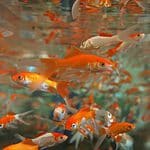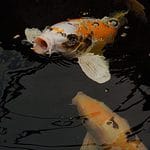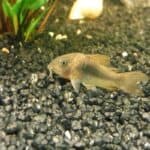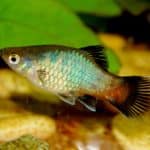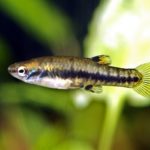Are you looking for the right size tank to get started? If yes, a 10 gallon fish tank setup is your best option.
It offers many advantages over something larger and can make a great addition to your living room or office. Not only is it small enough to fit in almost any space, but it is also easy to maintain and customize with decorations.
So, if you want the perfect size to get the hang of the basics of fishkeeping, without feeling overwhelmed with a larger tank, read this guide.
Why Choose A 10 Gallon Fish Tank Setup?
10-gallon tanks, despite their small volume, are very versatile aquariums. Even though they’re relatively small, as long as you follow some basic procedures, you won’t have problems with instability or poor water quality like smaller tanks.
An interesting part is that in these aquariums a multitude of species of fish, plants, and invertebrates can be kept. It is even possible to set up a community aquarium or more complex setups such as biotopes or a planted aquarium.
Most species to be kept in these aquariums are considered medium-sized fish, up to a maximum of 4 inches in size. These larger species should be kept alone, or with invertebrates if possible.
One of the interesting factors is that due to the small dimensions, 10 gallon tanks can be kept in several places. With the increasing growth of large urban centers, the spaces available for housing are getting smaller and smaller. This fact is one of the main reasons for the growing popularity of nano aquariums.
Due to its reduced size, it is a great option to place this type of tank in a small apartment, in our workplace, or even in a bathroom. Aquariums have proven anti-stress effects and can be a great addition to your routine.
Larger aquariums can be costly in financial and labor terms. The greater the tank volume, the greater the number of products and time spent on maintenance, such as water changes and cleaning. 10-gallon fish tanks are a low-cost alternative, especially when purchasing equipment, products, and decorations.
Maintenance is also simpler due to the small volume of water to be changed.
How Many Fish Can You Keep In A 10 Gallon Fish Tank Setup?
The number of fish to keep in a 10-gallon tank is relative to the species of fish you want to keep. Each fish has a specific size, behavior, and needs. You can keep small fish like Chilli Rasboras in a relatively large number (around 16 to 20 individuals), and along with these fish, you can also keep a few shrimp.
Larger and more aggressive fish like Bettas and Dwarf Gouramis should be kept alone. That way, you avoid fights and problems.
Aquarium stocking is, of course, the main limiting factor in 10-gallon fish tanks. This is due to the small physical space available and the low volume of water.
As for physical space, 10 gallons represent the actual volume. With the decorations, plants, equipment, and substrate, the size available for the animals to swim freely will be even smaller. This is a factor you should consider when designing your future aquarium.
The main problem with the small volume of water is the rapid changes in parameters that the aquarium can undergo. The little volume of water will not have sufficient capacity to disperse organic matter, ammonia, and other unwanted compounds naturally generated in aquariums. This causes above-optimal concentrations.
This problem is combative through the correct dimensioning of the filtering system and also through frequent maintenance.
Fish Species You Can Keep In A 10 Gallon Fish Tank Setup
As stated earlier, there are several species that you can comfortably keep in a 10-gallon tank.
When choosing species, preferably those that are hardy, resistant to parameter fluctuations, small in size, and not very active.
Avoid large, territorial, aggressive, sensitive fish or fish that require very specific conditions. These fish will hardly adapt to 10 gallons.
Guppy Fish
An old acquaintance of hobbyists, this fish is available in many colors and patterns at virtually any aquarium store in the world.
They are peaceful, easy to care for, can live in a wide range of parameters, and support (in emergencies) some system instabilities. It is a gregarious species but can be kept solitary without problems.
When using Guppy on your 10-gallon fish tank, the limiting factor is the same as one of its most interesting features. Being a very prolific fish, having at least one male and one female, your tank will quickly be full of fry that will overcrowd the aquarium.
The key here is to start with a low population of 1 or 2 trios (one male for two females). The species should be kept in a trio because the male will constantly harass the female; with more than one female in the tank, his attention will be divided, causing less stress on the females.
6 to 8 individuals in 10 gallons is a comfortable number to keep these fish. This way, the water quality will always be kept at the ideal level without requiring constant maintenance. Remove fingerlings or adult fish as they breed, if necessary in tanks with these fish.
Ballon Molly Fish
Ballon Molly fish is not one of the best species to keep at 10 gallons, as some females grow to large sizes and can become aggressive. The Balloon strain reaches a smaller maximum size and is less aggressive, making them great fish to be kept in nano aquariums.
They are easy to maintain and prefer hard alkaline water, so you should pay attention to the level of ammonia in the water. They are gregarious fish, which must be kept in a group. At 10 gallons, it holds 4 to 6 individuals.
Ballon Mollies aren’t as prolific as the regular molly, but as long as you have a couple in the tank, they will breed easily. Keep your mollies in a species-only aquarium.
Harlequin Rasboras
Harlequin Rasbora is a fish not highly recommended for tanks of this volume. This is because these fish are not so small in size (around 2 in), are active in behavior and live in large shoals. In an aquarium, schooling fish should be kept to a minimum of 6 individuals, which is impossible in 10 gallons.
Even so, there are aquarists who keep 2 to 4 individuals of these fish successfully in nano tanks.
They are peaceful fish and easy to keep. Just provide them with ideal conditions and good quality food and they will grow and live healthily.
Celestial Pearl Danio
The Celestial Pearl Danio is perfect for small tanks. Of sedentary habits, peaceful and small size, they can be kept in up to 8 individuals in 10-gallon tanks.
These fish are resistant, inhabiting a wide range of parameters and water with mild temperatures.
Platy Fish
Platy is a fish similar in size to the Guppy. Peaceful and gregarious in behavior, they are great for nano aquariums. Hold up to 6 individuals.
They are resistant and prolific fish which will soon reproduce. They prefer water ranging from neutral to alkaline and are sensitive to nitrogen in the water. Anyway, it’s a great species for beginners.
Sparkling Gourami
They are beautiful fish, small, and easy to care for. A perfect choice for your nano tank. It is a sociable and relatively peaceful species.
You can keep around 2 to 3 Sparking Gouramis in a species-only aquarium or 1 of these animals together with a small school of Celestial Pearl Danios.
They are very resistant and inhabit acidic waters with tropical temperatures.
Betta Fish
One of the ideal fish for 10-gallon aquariums. If you choose to keep a male, have only one, they are territorial fish that will fight with others of the same species. In the case of females, you can keep up to 3 in 10 gallons as they are less territorial than males.
In addition to keeping them in a species-only aquarium, it is a great species to keep in community tanks with shrimps and snails. You can even keep a male with a small school of Dwarf Corydoras or an Oto Cat.
Remember to have an aquarium with a filtration system for these animals, after all; they are fish with the same needs for good water quality as other species.
It is certainly the ideal fish for beginners and will become the king of the 10-gallon tank.
Neon Tetra
A beautiful species, with bright and strong colors. They are schooling fish; when they swim together, they leave the aquarium with a show of movements and colorful traces.
Neon Tetras like to live in slightly acidic or pH-neutral water and are resistant to parameter fluctuations. At 10 gallons, keep a school of 6 fish.
Essential Equipment For A 10 Gallon Fish Tank Setup
A 10-gallon aquarium requires the same equipment as any other aquarium. Equipment is vital for the aquarium to support the lives of the beings inhabiting it. Unfiltered and unconditioned aquariums are at the mercy of environmental conditions.
This means that, without a heater, the temperature will constantly fluctuate. The lack of a filtration system will cause a constant harmful accumulation of toxic compounds in the aquarium, preventing the maintenance of good water quality necessary to keep fish.
Stability is the key to good aquarium health.
Filter
The filter, or filtration system, is the centerpiece and essential in aquariums. It will house most of the bacteria responsible for degrading compounds such as ammonia, nitrite, and organic matter. These compounds are toxic and, if present in the water, will kill the fish, plants, and invertebrates that inhabit it.
Among the different types of filters, external filters best adapt to a small volume. Internal filters occupy a space inside the aquarium, reducing the space for the fish and, consequently, the volume of water.
Mini canisters are the more expensive alternative, but they are very efficient and have a good internal space to place different physical, biological, and chemical media. This type of filter is located outside the tank, with only the inlet and outlet hoses submerged.
Another type of filter that is just as efficient is the H.O.B. filter. The downside, compared to mini canisters, is the size of the place to insert filtering media, which is reduced. However, it is an easy filter to assemble and carry out cleaning maintenance.
These filters are hung on some of the aquarium’s glass, with an inlet pipe into the water. The water returns to the aquarium through a waterfall in front of the filter.
Other filters we see in small aquariums are the sponge or foam type. These filters work through air compressors. They are very efficient but take up considerable internal space.
When choosing your filtration system, we recommend choosing one with water flow regulation. So you can provide different flow speeds.
Heater
The heater is essential for adjusting the temperature and, more importantly, keeping it stable. In case of temperature fluctuations, fish will feel and are likely to get sick quickly.
Of course, heaters will be responsible for keeping the temperature on the hot side; otherwise, we use coolers.
Lights
The lighting factor is something very variable in aquariums. If you only keep fish and plants considered low-tech (which don’t have many requirements regarding light and fertilization), the light will serve the tank’s inhabitants to regulate their internal cycle and know when it is day or night. An artificial lighting system is often unnecessary when the aquarium receives indirect light.
If we are talking about a planted aquarium with high-tech plants (which demand a lot of light and nutrients), or even a reef tank, quality lighting will be necessary. There are several models, brands, and manufacturers of specific aquarium lighting systems on the market, and the best thing you can do is get one of these. You will find models already sized for 10 gallon tanks.
Air Pumps and Bubblers
You will not need this equipment unless you use the aforementioned sponge filter. Air pumps and bubblers increase gas exchange in aquariums by breaking the surface tension of the water. That is, they oxygenate the aquarium through agitation.
In 10 gallon tanks, this churning is likely to put a lot of stress on the fish. It will be constant turmoil in the aquarium. Don’t worry; the filtration system will be enough to promote gas exchange in your tank.
Stands and Lids
The place where the tank will be supported is essential to guarantee the physical integrity of the aquarium. Always support it on flat and completely level surfaces, otherwise, it may crack and even break the bottom of the tank.
Lids are not always necessary. Aquariums with lids have a lower rate of gas exchange with the medium. But some fish, like the Betta, are known to jump out of an aquarium, so using a lid reduces accidents and deaths.
How to Set Up A 10 Gallon Fish Tank
After obtaining the equipment, the next step is to place the aquarium in the chosen location and assemble it. Let’s talk a little about the best way to do this.
1. Set up the equipment and tank.
This part is simple, place your aquarium in the chosen location. Make sure it is a stable surface and a ventilated place away from the sun. Separate everything you will use and leave it within reach of your hands and eyes.
Never place your aquarium in direct sunlight or very hot places. Placing the tank in a cool place, with good air circulation, and out of direct sunlight will prevent the aquarium from several problems like overheating and stress induced by high light.
It is important to have easy access to the electrical outlet to connect the equipment.
2. Choose the right substrate.
The substrate can either be decorative (for species that do not depend on it, such as Guppies) or essential for fish health (for fish such as Coolie Loach, which buries themselves).
Among the various options available, we always prefer natural ones, without chemical pigments. They must be rounded, without sharp edges that could harm the fish.
For planted aquariums, use a fertile substrate suitable for the good health of the plants.
Some substrates come with accumulated dirt, so, ideally, you wash them in running water before placing them in your aquarium. This can be done with the help of a bucket or sieve.
Place the substrate in the aquarium little by little. Then arrange it with the help of some flat tool like a ruler.
3. Add the filter, pump, and heater.
After placing the substrate, you will assemble the equipment. Each piece of equipment has a correct way of use, according to the model and company that made it.
Follow the manufacturer’s information to allocate and connect them correctly.
4. Add water to the fish tank.
One of the most awaited parts by aquarists. With the aquarium set up and the equipment positioned, with the help of a bucket or hose, fill your aquarium.
The water from the supply network is loaded with products such as chlorine and chloramine. These products are responsible for leaving us humans drinking water, but they are toxic to aquatic animals. To remove these substances, you must use a product known as a water conditioner.
5. Add plants and decorations.
Here’s a tip: add plants and decorations when the aquarium is half full. This way, you avoid spills and if the water gets dirty, you can quickly remove water and refill the tank.
Arrange the plants and decorations to suit you best and provide the tank’s inhabitants with what they need, such as hiding places and planted areas. Remember that the more the number of things inside the aquarium, the smaller the amount of water and space available.
6. Cycle the fish tank.
After your aquarium is set up, you must leave the aquarium with the equipment on and wait a while before inserting the fish. During this period, the beneficial bacteria will reproduce and stabilize in the tank. These bacteria will support life, removing toxic compounds from the aquarium water.
The time for cycling varies from 14 to 31 days. You will know that this period has been completed after repeatedly running ammonia, nitrite, and nitrate tests. Tests should always be at 0 ppm.
7. Adding your new fish to the tank.
After your aquarium is cycled and set up, it’s time for you to add the fish. This is a part that requires some care. The bag from the store has water with different properties from those of your aquarium, so before releasing the fish, you must perform what we call acclimatization.
Leave the bag floating in the aquarium for about 15 minutes so that the bag’s temperature will balance with that of the aquarium. Then open the bag and insert some of the aquarium water, wait a few minutes and add some more. When the bag has doubled the volume of water, discard the water and insert the fish into the tank.
Ideally, you want to insert your fish little by little, preferably every 5 days; that way, the bacteria in the filter have time to adapt to the new bioload in the tank.
10 Gallon Fish Tank Setup FAQs
How much does a 10 gallon fish tank weigh?
This will directly depend on the number of decorations and substrates you used. But a 10 gallon, water-only tank weighs around 111 pounds.
What big fish can live in a 10 gallon fish tank?
No big fish can live in this setup. You should keep solitary species no more than 4 inches in length.
Do you need a filter for a 10 gallon fish tank?
Yes. Every aquarium requires a filtration system.
Does a 10 gallon fish tank need an air pump?
No. Air pumps will create unnecessary turbulence in the water. It is only needed if you use a foam filter.
What are the dimensions of a 10 gallon fish tank?
A 10 gallon tank measures standard 20 inches in length (L), 10 inches in width (W), and 12 inches in height (H).
References
Alderton, D. (2019). Encyclopedia of aquarium and pond fish. Dorling Kindersley Ltd.
Arndt, R. G., Quattro, J. M., & Foltz, J. W. (2009). Freshwater Fishes of South Carolina (No. 22). Univ of South Carolina Press.


